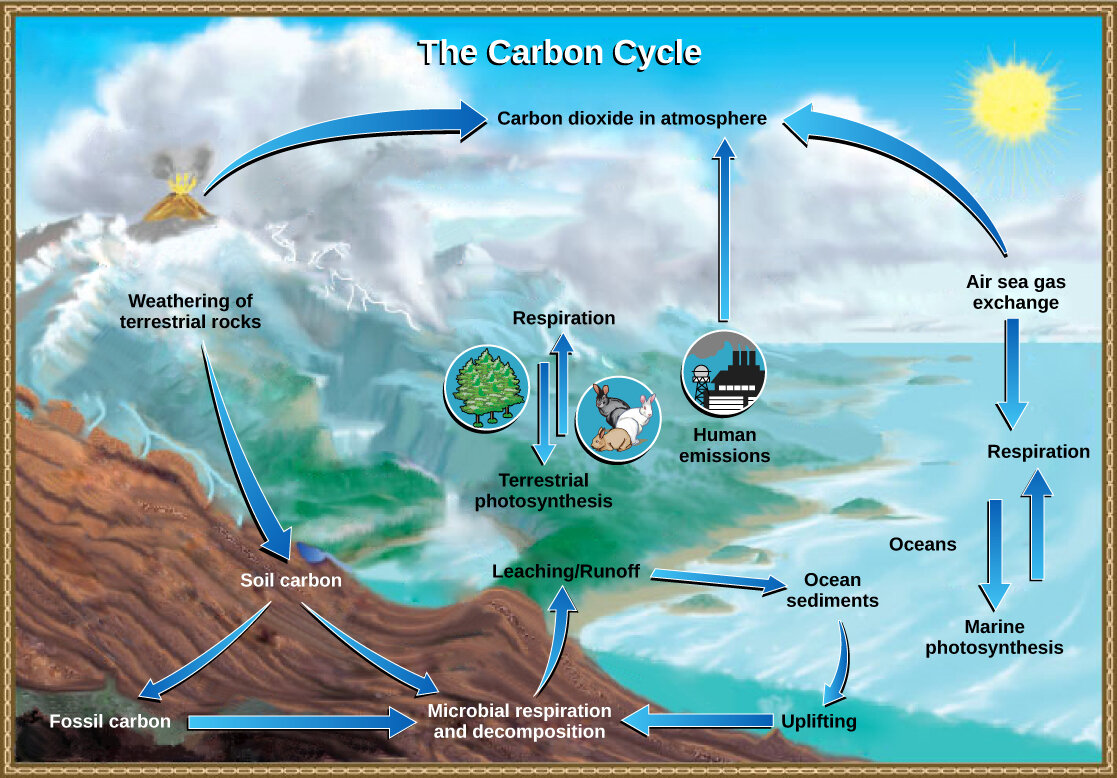Utilizing Blue Carbon to Mitigate Climate Change
Contributor: Jackie Vandermel
Introduction and Significance: Blue Carbon
Blue carbon (BC) is the carbon dioxide (CO2) that Earth’s marine ecosystems, such as the deep sea, and coastal ecosystems, such as seagrasses, capture. Specifically, when bodies of water and coastal lands are healthy and protected, they have incredible carbon capture and sequestration (CCS) capabilities—capturing CO2 and storing it. The National Oceanic and Atmospheric Administration (NOAA) states that oceans alone absorb 31% of the atmosphere’s CO2.
Thus, various leaders and organizations are interested in working with BC projects to mitigate the impacts of climate change. From 2017 to 2020, 28 countries have included marine and coastal ecosystems in their Nationally Determined Contributions to the United Nations Framework Convention on Climate Change. Specifically, Article 5.1 in the Paris Agreement Rulebook states that governments should conserve and enhance “sinks and reservoirs of all greenhouse gases not controlled by the Montreal Protocol, including… oceans as well as other terrestrial, coastal and marine ecosystems.”
How do BC ecosystems capture CO2?
CO2 is soluble in water (H2O), so at its surfaces, bodies of water chemically dissolve CO2: CO2 (aqueous) + H2O (liquid) → H2CO3 (aqueous). The product of this chemical reaction is carbonic acid.
In water, CO2 can remain as a dissolved gas, but marine life typically uses it for other things. This is because photosynthesis and cellular respiration, for example, which marine plants and animals do for energy and food, are components of the carbon cycle.
Figure 20.10, John M. Evans and Howard Perlman
For example, marine plants like phytoplankton lie at the surfaces of oceans, and use sunlight, water, and CO2 for photosynthesis. The CO2 becomes organic matter, or food, for phytoplankton.
Wetlands, Land Trust Alliance
Past the water’s surface, CO2 travels deeper into bodies of water, where organisms such as oysters use CO2 to build and maintain their shells. Specifically, in a process known as biomineralization, oysters extract calcium and carbonate ions from surrounding seawater, which combine to produce calcium carbonate, or the skeleton of a shell: Ca + CO3 → CaCO3.
When these organisms die, their bodies decay, which releases the CO2 their shells and other body parts contained, into the water. CO2 ultimately sinks to the seafloor and becomes stored in stone that decaying shells or sediment cement into.
Research and Projects
The term “blue carbon” began being used in 2009, and BC projects soon followed. A specific BC project that is said to slow climate change impacts is incorporating wetlands, areas where water covers soil, into voluntary carbon markets. Following the greenhouse effect, some believe that it does not matter where or how much CO2 each person emits as long as the country and world the person resides in does not exceed its emissions limits. Thus, governments have established carbon markets, where people can buy, sell, or trade emissions or emissions reductions (or “carbon offsets”). However, the carbon market is typically active for detailed reasons, for when people find reducing emissions in a certain area to be less costly and more effective and efficient than in other areas.
Support Carbon Markets, Land Trust Alliance
Unlike mandatory carbon markets, voluntary carbon markets (VCM) are not regulated by “national, regional, or international carbon reduction regimes,” meaning companies and individuals can purchase carbon offsets without having to do so for or under their governments.
In 2011, a BC project that involved wetlands and VCM was introduced. It was called “Bringing Wetlands to Market”, and organizations such as the Waquoit Bay Reserve proposed that companies and individuals fund wetland restoration projects, stating that this could benefit the environment and financial well-being of contributing communities. Wetlands currently store 700 billion tons of CO2 and sequester 96 million tons of CO2 per year, but 50 percent of the world’s wetlands have been destroyed or degraded since 1900, so restoration efforts would boost these CCS abilities. This carbon offset would lead to the world being less polluted, and for governments, this means there is less pollution to tax. Federal and state carbon taxes would thus be reduced, helping communities financially.
With support and 1.3 million dollars granted by the NOAA’s National Estuarine Research Reserve Science Collaborative, the Waquoit Bay Reserve conducted research on “how tidal wetland greenhouse-gas fluxes, and potential carbon storage, will change under different conditions.” Later, they developed a tool and guide on marketing the project, which has since been brought to states such as Texas, Oregon, and Alaska.
Additionally, in 2014, Louisiana conducted similar research, as since 2011, it accounted for “90% of all coastal wetland loss” in the US. They found that coastal wetland restoration through four techniques could produce over 1.8 million offsets per year and a revenue between 500 and 1600 million dollars over 50 years.
Net offset potential in Louisiana by wetland restoration type including a 20% buffer deduction, Sarah K. Mack, Christine Yankel, Robert R. Lane, John W. Day, Dick Kempka, J. Stephen Mack, Elizabeth Hardee, and Christina LeBlanc
Problems and Conservation Efforts
Since 1971, oceans alone have absorbed 90 percent of the warming that has happened on Earth. However, marine and coastal ecosystems suffer as they help slow the accumulation of atmospheric CO2, or global warming.
To begin, too much CO2 in the atmosphere and then bodies of water leads to acidification. When CO2 is put into the atmosphere, it reacts with clouds’ water particles and forms acid rain, which eventually falls into bodies of water. CO2 can also more directly react with bodies of water, as CO2 and seawater react to produce carbonic acid. The problem is that marine life, such as oysters, corals, and starfish, have a difficult time building shells in acidic, salty environments. Furthermore, with warmer waters, the amount of oxygen in the water decreases, affecting all marine life.
And most detrimental, if these ecosystems are destroyed, the BC they have stored for centuries will be emitted into the atmosphere and contribute to the devastating impacts of climate change. For example, degraded wetlands release about 450 million tons of CO2 each year, which is more than Australia’s CO2 emissions in 2016.
Thus, organizations such as the Blue Carbon Initiative, with its International Blue Carbon Scientific Working Group, and International Blue Carbon Policy Working Group, works to research and provide guidance for needed projects and policy implementation.
In 2020, Senate Oceans Caucus co-chairs U.S. Senators Lisa Murkowski and Sheldon Whitehouse introduced Blue Carbon for Our Planet Act (H.R.5589), a policy that would establish an Interagency Working Group on Coastal Blue Carbon to develop national strategies that fund research to protect and restore regional, coastal, and national blue carbon ecosystems.





